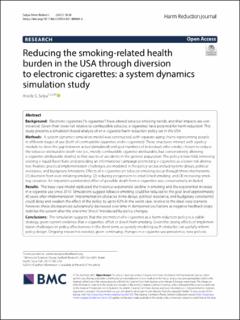| dc.description.abstract | Background
Electronic cigarettes (“e-cigarettes”) have altered tobacco smoking trends, and their impacts are controversial. Given their lower risk relative to combustible tobacco, e-cigarettes have potential for harm reduction. This study presents a simulation-based analysis of an e-cigarette harm reduction policy set in the USA.
Methods
A system dynamics simulation model was constructed, with separate aging chains representing people in different stages of use (both of combustible cigarettes and e-cigarettes). These structures interact with a policy module to close the gap between actual (simulated) and goal numbers of individuals who smoke, chosen to reduce the tobacco-attributable death rate (i.e., mostly combustible cigarette-attributable, but conservatively allowing e-cigarette-attributable deaths) to that due to all accidents in the general population. The policy is two-fold, removing existing e-liquid flavor bans and providing an informational campaign promoting e-cigarettes as a lower-risk alternative. Realistic practical implementation challenges are modeled in the policy sector, including time delays, political resistance, and budgetary limitations. Effects of e-cigarettes on tobacco smoking occur through three mechanisms: (1) diversion from ever initiating smoking; (2) reducing progression to established smoking; and (3) increasing smoking cessation. An important unintended effect of possible death from e-cigarettes was conservatively included.
Results
The base-case model replicated the historical exponential decline in smoking and the exponential increase in e-cigarette use since 2010. Simulations suggest tobacco smoking could be reduced to the goal level approximately 40 years after implementation. Implementation obstacles (time delays, political resistance, and budgetary constraints) could delay and weaken the effect of the policy by up to 62% in the worst case, relative to the ideal-case scenario; however, these discrepancies substantially decreased over time in dampened oscillations as negative feedback loops stabilize the system after the one-time “shock” introduced by policy changes.
Conclusions
The simulation suggests that the promotion of e-cigarettes as a harm-reduction policy is a viable strategy, given current evidence that e-cigarettes offset or divert from smoking. Given the strong effects of implementation challenges on policy effectiveness in the short term, accurately modeling such obstacles can usefully inform policy design. Ongoing research is needed, given continuing changes in e-cigarette use prevalence, new policies being enacted for e-cigarettes, and emerging evidence for substitution effects between combustible cigarettes and e-cigarettes. | en_US |

